Our roots date to 1848, distinguishing us as the oldest Jewish congregation in Indiana. Since its founding, the Temple has resided in four different synagogues. The current facility on Old Mill Road became our home in 1961.
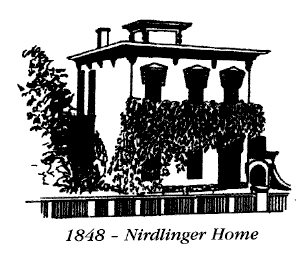 The founders held religious services in the home of Frederic Nirdlinger until 1859 when they had their formal house of worship. Men and women worshiped in separate parlors in keeping with Orthodox German traditions. Records show the founders were Nirdlinger as president, Sigmund Redelsheimer as vice-president, Isaac Wolf as treasurer and Isaac Lauferty as secretary. For 157 years, a direct descendent of those founding families remained a member of the Temple, a tie that ended in March 2005 with the death of Madelon Rothschild, a great-granddaughter of Sigmund Redelsheimer.
The founders held religious services in the home of Frederic Nirdlinger until 1859 when they had their formal house of worship. Men and women worshiped in separate parlors in keeping with Orthodox German traditions. Records show the founders were Nirdlinger as president, Sigmund Redelsheimer as vice-president, Isaac Wolf as treasurer and Isaac Lauferty as secretary. For 157 years, a direct descendent of those founding families remained a member of the Temple, a tie that ended in March 2005 with the death of Madelon Rothschild, a great-granddaughter of Sigmund Redelsheimer.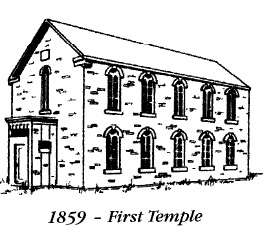 In 1859, our numbers had increased and we moved to our first temple, an old German Methodist Church at Wayne and Harrison streets, bought for $1,200. The dedication ceremonies on Sept. 23, 1859 were attended by many Christians and were considered so impressive that the ceremonies were repeated the following day.
In 1859, our numbers had increased and we moved to our first temple, an old German Methodist Church at Wayne and Harrison streets, bought for $1,200. The dedication ceremonies on Sept. 23, 1859 were attended by many Christians and were considered so impressive that the ceremonies were repeated the following day.During Rabbi Rubin’s tenure, the Union of American Hebrew Congregations was founded in 1873. In May 1874, we became a Reform Congregation and joined the Union.
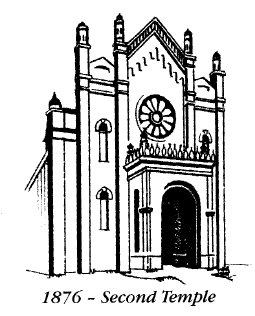 Not everyone agreed with the move to Reform Judaism. In February 1866, a group of members withdrew, founded its own congregation and burial ground, and continued in existence for several years before returning to the fold of Achduth Vesholom. During this time, we’d again outgrown our quarters. Remodeling was impractical and too expensive, so we built a new Temple on ground purchased 12 years before at the corner of Harrison and Wayne. This first building drive attempted to raise $19,000 through fairs, lectures, picnics and a masked ball. The building was dedicated on January 7, 1876.
Not everyone agreed with the move to Reform Judaism. In February 1866, a group of members withdrew, founded its own congregation and burial ground, and continued in existence for several years before returning to the fold of Achduth Vesholom. During this time, we’d again outgrown our quarters. Remodeling was impractical and too expensive, so we built a new Temple on ground purchased 12 years before at the corner of Harrison and Wayne. This first building drive attempted to raise $19,000 through fairs, lectures, picnics and a masked ball. The building was dedicated on January 7, 1876.
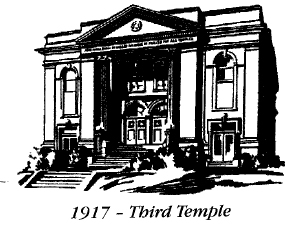 Our third home in 1917
Our third home in 1917 The move to Old MIll Road
The move to Old MIll RoadLater that year, the Temple Sisterhood voted to disband. The move came as a result of busy schedules at work and home, as well as recognition that women serve vital roles in all levels of congregational leadership and didn’t need a separate organization.
The Torah came to us with the last half of Numbers and first half of Deuteronomy intact. Master Sofer Dr. Eric Ray came to Fort Wayne and began writing the opening sections of Genesis and explained the intricate process of Torah writing. He then continued working on the Torah sections in New York and Israel for nearly a year to incorporate new sections with the old ones. He returned to Indiana to finish the final sections of the Scroll in time for Simchat Torah and the 150th anniversary gala. Bill Brosler, who died at age 101 in January 1998 after serving as the Temple’s chief usher for 50 years, underwrote the cost of the restoration effort so that donations for the project could boost the Temple’s Endowment for the future.
In the mid 1998, the Temple entered cyberspace, launching its website.
The Temple purchased additional land at Lindenwood Cemetery in 1999 to accommodate 209 more plots. The original graves in our section date to 1886.
In fall 2000, Rabbinic Intern Karen Bodney joined us for a two-year stay.
Rabbi Marla Joy Subeck Spanjer became the congregation’s 20th spiritual leader and first woman rabbi in July 2007. Her contributions included leading a study group dedicated to Mussar and interfaith efforts in the community, including a year-long television show with local Christian and Muslim clergy.
The congregation formally adopted the Union for Reform Judaism’s new Mishkan T’fillah prayer book in February 2008, replacing The Gates of Prayer.
In the summer of 2010, Rabbi Javier E. Cattapan joined the Temple after serving for 12 years as spiritual leader of Temple Beth Israel-Shaare Zedek in Lima, Ohio. A native of Argentina, Rabbi Cattapan came to the United States in 1994 to attend Hebrew Union College in Cincinnati. Building on his love of music and singing, Rabbi Cattapan incorporated music from all over the Jewish world into services, classes and presentations.
Our commitment to Tikkun Olam (repairing the world) took a new form in October 2010 with a project called Thoughtful Thursdays. The Temple joined with the Jewish Federation of Fort Wayne and Congregation B’nai Jacob to regularly assist 85 children who attend Head Start at the Temple. Through this dynamic social action program, the Jewish community sends home to the Head Start families a bag on one or two Thursdays a month with food and an educational project. All the Head Start families have incomes below the federal poverty level. The program has branched out to include a tea in December to enable some of the Jewish community volunteers to interact with the Head Start families. A Temple member who is a retired teacher also works with Head Start parents and teachers on educational ideas that can be utilized at home and in class. Most recently, some of the materials have been translated into Spanish by a volunteer. We received an Irving J. Fain Social Action Award from the Religious Action Center of Reform Judaism for Thoughtful Thursdays in 2013.
In March 2012, the congregation established the L’dor Vador Legacy Society to recognize individuals whose generosity and dedication will help support future generations. Anyone may join the Legacy Society at any time by providing a letter of intent that they’ve made arrangements for a planned gift. Members of the Society are recognized each June at the Temple’s Annual Meeting.
Our volunteer Hazemir Choir celebrated its 26th and final birthday on October 26-28, 2012. Former Hazemir members came from across the country to mark this special milestone. Friday evening services featured the world premier performance of a composition by Dr. John Planer, the choir’s founder and director, entitled “Sortie de la Torah,” a setting of the liturgy for taking the Torah from the Ark. It originally was written in 1985 for the choir at the Synagogue de la Paix in Strasbourg, France. Dr. Planer told the congregation that a prominent and influential member of the choir said of the composition “ce n’est pas notre tradition” (“this is not our style”) and it consequently was never performed. It was in style for Achduth Vesholom, as it drew generous applause from the congregation. For 26 years, Dr. Planer nurtured and taught the a cappella choir. In recognition of his leadership and commitment, the Board of Trustees honored him by creating the Dr. John Planer Music Fund.
The congregation began using the new High Holy Days prayer book Mishkan Hanefesh in 2015. It was the Reform Movement’s first new machzor in 40 years.
Vision for the Future
As part of strategic planning efforts, the congregation decided in June 2012 to re-envision our current home at 5200 Old Mill Road to sustain the Temple, strengthen the Jewish community, and serve some of the neediest families in Fort Wayne. This effort has become the Rifkin Campus at 5200. The facility now houses the Jewish Federation of Fort Wayne, the Fort Wayne Jewish Cemetery Association, IPFW’s Institute for Holocaust and Genocide Studies, and long-time resident Brightpoint Head Start. We broke ground in October 2015 for the Madge Rothschild Resource Center and held a formal dedication in April 2017.
The $1.07 million Madge Rothschild Resource Center is the centerpiece of the project. It’s dedicated to the Jewish Experience in Northeast Indiana over the past two centuries, promoting Holocaust education as we strive for greater understanding among all faiths and people, and to bringing the Jewish and greater community together for programming and social events. The resource center houses the Rabbi Richard B. Safran Library and the Jacob Goldman Memorial Museum, which is under development.
We regularly work with our Campus partners and others in the community for programming. Highlights include:
- The Temple’s Holocaust Education Committee has partnered with PFW’s Institute for Holocaust and Genocide Studies and The Genealogy Center at the Allen County Public Library to offer programming to the wider community, including guest speakers and a “Genealogy and the Holocaust” program.
- The Holocaust Education Committee and the PFW’s Holocaust and Genocide Studies staff offered a one-week symposium in May 2016 to pre-service educators to teach them as much as possible about details of the Holocaust, as well as how to teach students of various grade levels about the Holocaust. Another symposium is under development for 2018. The committee also is developing a Holocaust Speakers Bureau.
- The Temple has partnered with the Jewish Federation of Fort Wayne and PJ Library for programming for young children in the Madge Rothschild Resource Center.
- The community’s annual Interfaith Thanksgiving Service regularly brings together a large group at the Temple.
In July 2016, Rabbi Lenny Sarko became spiritual leader of the Temple. Building on his experience with technology, Rabbi Lenny in Fall 2016 introduced TempleConnect, a videoconferencing system, and the congregation began offering online worship, Talmud, and other learning opportunities.
Members of Fort Wayne’s two Jewish congregations voted in spring 2019 to come together as one congregation with two traditions. Members from Congregation B’nai Jacob, a Conservative egalitarian synagogue, became members of Achduth Vesholom on July 1, 2019. Achduth Vesholom, which remains Reform in philosophy and practice, also began offering traditional worship options in August 2019. B’nai Jacob was founded in 1912.
Rabbi Paula Jayne Winnig joined Achduth Vesholom in August 2019 as Interim Rabbi through June 30, 2020. During her tenure, Rabbi Winnig helped with the transition at the Temple and worked with the ritual committee to integrate worship traditions.
With respect for the long history of B’nai Jacob, Rabbi Winnig led a meaningful deconsecration ceremony of the synagogue building on Bittersweet Moors Drive and a burial at the Fort Wayne Jewish Cemetery of worn books and unneeded sacred items. She also created a beautiful Simchat Torah service as part of our B’yachad (together) celebration.
As part of the community-wide Violins of Hope programming sponsored by the Jewish Federation of Fort Wayne and the Fort Wayne Philharmonic in November 2019, she created a Shabbat service incorporating the music of European Reform synagogues in the years leading up to the Holocaust. Also through Violins of Hope, Rabbi Winnig participated with Bishop Kevin C. Rhoades in a Jewish-Catholic prayer service focusing on shared religious connections.
To further reflect the larger and strengthened congregation, renovations to worship space led to the completion in spring 2020 of the renamed Goldstine-B’nai Jacob Chapel. Bringing together lovely new touches with treasured pieces from both B’nai Jacob and Achduth Vesholom, the renovated space also includes new flooring, seating, cooling system, kitchenette, lighting, and energy-efficient windows.
Enhancing the space are the Ark from the former B’nai Jacob building on Bittersweet Moors Drive (with its beautiful backdrop), stained glass from the synagogue’s previous facility on Fairfield, and stained-glass windows from Achduth Vesholom’s long-time home built in 1916 at Wayne and Fairfield. The hallway outside the chapel now features the cornerstones from previous B’nai Jacob buildings and stained glass from its entryway on Bittersweet Moors.
Global Pandemic Impacts the Temple
Just as Shabbat began on March 13, 2020, the Temple and Rifkin Campus closed its doors temporarily in response to the global COVID-19 pandemic. The Temple board had decided the evening before that this cautious step was necessary to look out for the Jewish and larger community. From the Sanctuary, Rabbi Winnig recorded a video for Facebook, lighting Sabbath candles, sharing Kiddush, reciting Mi Shebeirach and Kaddish prayers, and offering an uplifting message for Shabbat addressing the unprecedented health crisis.
During the next year, the Temple’s worship, classes, meetings, and gatherings shifted to online offerings via Zoom videoconferencing. Rabbi Winnig provided a vital role in adapting to the fast-changing situation. Temple staff and leadership worked virtually to keep Temple operations running smoothly.
On April 4, 2020, the congregation shared its first virtual Bar Mitzvah when Leo Powell and his immediate family celebrated this milestone via videoconferencing from home with the Rabbi and congregation joining him from 60 separate locations. Over the next weeks, a memorial service and baby naming also were held online. Weekly Shabbat worship, as well as observances for Passover and Shavuot, were held on Zoom.
The congregation held its first virtual Annual Meeting on June 10, 2020. Led by President Ellen Tom, the 172nd gathering brought together nearly 100 members online to discuss Temple business, with voting held by absentee ballot in advance of the meeting.
Rabbi Meir Bargeron became the congregation’s 24th spiritual leader on July 1, 2020. With the building still closed, Rabbi Meir began his new pulpit leading virtual services and getting to know congregants through small gatherings on Zoom.
He and the staff began doing essential work in the building, taking precautions for social distancing and wearing face masks. The board decided in July that no in-person worship would be held during the High Holy Days 5781 and planning began for online worship of both Reform and traditional services. Rifkin Campus partners were able to access their offices within health and safety guidelines.
In September, Brightpoint Head Start resumed in-person classes at the Temple with about half the number of students as compared to 2019 when 72 children attended. Staggered attendance schedules and new COVID-related safety measures were put into place.
For the High Holy Days 2020, only the service leaders and essential support personnel were in the building. Rabbi Meir led Reform services with guest Cantor Yvon Shore and Maestro Robert Nance from the Sanctuary. The services on Rosh Hashanah and Yom Kippur were streamed via a new Temple YouTube channel. Traditional services, led by Pamela & Ron Friedman from the Goldstine-B’nai Jacob Chapel and guest shaliach tzibor Michael Small in Chicago, were offered via Zoom.
Some parts of the service were pre-recorded to allow for members to participate while observing social distancing and safety protocols. On September 10, members were scheduled 15 minutes apart throughout the day to record their parts.
The most intricate part of the production came for Kol Nidre when six congregants each held a Torah in a line on the bimah though they never actually were in the room together. They were recorded at different times and united by an intricate plan and seamless editing.
Spaces were blocked out in advance so that each person would eventually be in height order holding the Torah on the appropriate side for the shot to be successful. Each was recorded from three different angles at 40 seconds per angle and then edited together to look like they were next to each other.
The Temple’s only in-person event during the High Holy Days (and during the first eight months since the building closed) was outdoors on the second day of Rosh Hashanah when some 90 congregants gathered on September 20 in the Temple parking lot for a shofar and Tashlich service wearing masks and social distancing.
In October 2020, a seven-member COVID Task Force was named to develop a reopening plan for the Temple to help guide our congregational leadership in making informed decisions about resuming activities at the Rifkin Campus. They recommended protocols for congregants, staff, tenants, and visitors and collaborate with the leadership and staff to implement safety measures.
Our largest fundraiser – the Corned Beef on Rye – Sure to Satisfy sale – was postponed in November 2020. Lifelong learning classes, meetings, and other programs continued online.
Our virtual congregational life included Hanukkah at Home, a nightly celebration on Zoom led by Rabbi Meir or congregants to bring the community together, and an online Second Seder that focused on the Seder Plate.
With the increasing availability of vaccines and improving COVID numbers in the community, the Temple Board decided in February 2021 to proceed cautiously with a phased reopening of the building for worship.
After a year of being closed due to the pandemic, the Temple returned to in-person services in the Sanctuary in April 2021. With a focus on health and safety, protocols included limitations on crowd size, strict mask and distancing guidelines, and reservations to attend. Livestreaming of worship continued. The first life-cycle event in person after the pandemic was the baby naming of Ophira Ruth Soltz.
The building opened for some in-person activities in May 2021, including the last day of Religious School. The congregation met on June 9, 2021 for its 173rd Annual Meeting in the building and via livestream.
Returning to Normalcy
In Fall 2021, the Temple introduced KESHER (“Connections”) programming to build connections among our families and youngest congregants through an engaging mix of virtual and in-person Jewish learning experiences. Religious School students meet online with other
Achduth Vesholom’s 19th Corned Beef Fundraiser returned in November 2021, adapting to the times by creating a new drive-thru order and pick-up plan that proved popular and returned in 2022. In honor of our 20th Corned Beef Fundraiser, Mayor Tom Henry issued a city-wide proclamation declaring November 3, 2022 as “Corned Beef on Rye Day” in Fort Wayne.
The Temple added a digital yahrzeit display in fall 2021 to provide a special way to remember our loved ones and continue the Jewish tradition of observing the anniversary of their passing.
A year later, on September 30, 2022, we dedicated a new yahrzeit sculpture incorporating nearly 1,000 bronze yahrzeit plaques that previously were on the walls of Achduth Vesholom and B’nai Jacob. Located in the courtyard of the Madge Rothschild Resource Center, the sculpture was designed by artist George Morrison.
Continuing our commitment to tikkun olam (repairing the world), the Temple and Jewish Federation of Fort Wayne raised nearly $22,000 in December 2021 to assist Afghan refugees who were resettled in our community by Catholic Charities of Fort Wayne. Our social action focus has included sacred conversations with our interfaith partners in focusing on Reproductive Justice.
Recognizing changing expectations for incorporating livestreaming for education, worship, and other activities, the Temple’s membership in June 2022 approved a major upgrade to our livestreaming equipment.
The Temple is excited to celebrate its 175th anniversary at Indiana’s oldest Jewish congregation in fall 2023.
